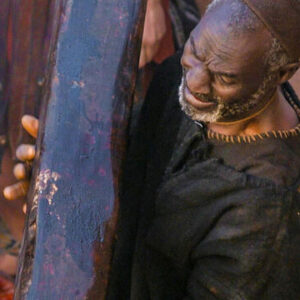 Religious symbolism has meaning! For instance, it’s not unusual to find young Christians wearing a necklace or sporting a tattoo with the yin and yang symbol, never realizing that it is a symbol for the false teachings of Eastern religion. The black and white Yin Yang represents part of the Taoist religion which teaches that nature is filled with opposites like dark and light, hot and cold, and these opposites must be kept in constant balance. It also means that good and evil or virtue and vice should also be balanced in life. It teaches that there are no absolutes, no ultimate good, and thus no room for a perfect God or the death of his perfect Son. In reality the Yin Yang symbol is the opposite of everything that Christianity stands for. Yes, religious symbolism does have meaning! To the Christian, the sign of the cross tells the story of sin and salvation. It reminds believers of the sacrifice that was made once and for all on the hill at Calvary. And, moreover, the empty cross serves as a special sign that death no longer has a hold over us because Jesus is no longer dead. He has risen from the grave to prove to us that he has power over death and we will also rise to live with him forever.
Religious symbolism has meaning! For instance, it’s not unusual to find young Christians wearing a necklace or sporting a tattoo with the yin and yang symbol, never realizing that it is a symbol for the false teachings of Eastern religion. The black and white Yin Yang represents part of the Taoist religion which teaches that nature is filled with opposites like dark and light, hot and cold, and these opposites must be kept in constant balance. It also means that good and evil or virtue and vice should also be balanced in life. It teaches that there are no absolutes, no ultimate good, and thus no room for a perfect God or the death of his perfect Son. In reality the Yin Yang symbol is the opposite of everything that Christianity stands for. Yes, religious symbolism does have meaning! To the Christian, the sign of the cross tells the story of sin and salvation. It reminds believers of the sacrifice that was made once and for all on the hill at Calvary. And, moreover, the empty cross serves as a special sign that death no longer has a hold over us because Jesus is no longer dead. He has risen from the grave to prove to us that he has power over death and we will also rise to live with him forever.
Matthew, Mark, and Luke are the three gospel writers who mention Simon of Cyrene as the unexpected passerby who was commissioned to carry Jesus’ cross. “As they led him [Jesus] away, they seized Simon from Cyrene, who was on his way in from the country, and put the cross on him and made him carry it behind Jesus” (Luke 23:26). Cyrene is located in northern Africa, and why he was in Jerusalem is not mentioned. Perhaps it was to join in the Passover celebration. If that was the case, this incident ruined it for him because after carrying this instrument of death, he would no longer be allowed to celebrate the Passover. It is likely he carried the cross piece, or patibulum, of the cross that weighed about 100 pounds. Fortunately, Simon was put into service to assist the Savior.
Jesus mentioned the symbol of the cross long before his crucifixion. When teaching his disciples what it takes to be a true follower, Jesus said, “If anyone would come after me, he must deny himself and take up his cross daily and follow me” (Luke 9:23), and a few days later, “Anyone who does not carry his cross and follow me cannot be my disciple” (14:27). The picture of Simon carrying Jesus’ cross is certainly symbolic of the cross that each of us must carry as followers of Jesus.
Paul refers to the symbol of the cross a dozen times in his writing. The early Christians realized that the cross was a symbol of life and conviction. Over the years that symbol has kept its significance, and today it can be found not only in our churches but in our homes as well. Many of us even wear it throughout the day. It is one of the first signs our children learn to recognize, and it is certainly the one that is held dearest at the time of death. Paul said it so beautifully to the Galatians: “May I never boast except in the cross of our Lord Jesus Christ” (Galatians 6:14).
Simon of Cyrene didn’t know the significance of what he was struggling to carry that Friday. The tool of torture that chafed his back was the same tool of salvation on which his sins were forgiven.
We have little information as to what became of Simon. Did he come to know the One who was nailed to the crossbeam he bore? Some speculate that his sons, who were with him in Jerusalem, became followers of Jesus and were instrumental in the infant Christian church. (See Mark 15:21 and Romans 16:13.)
Religious symbols do have significant meaning! George Bennard knew that well when he wrote the lyrics that have become so dear to every soldier of the cross.
Oh that old rugged cross, so despised by the world,
Has a wondrous attraction for me;
For the dear Lamb of God left his glory above to bear it to dark Calvary.
